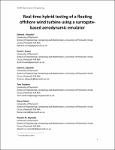Real-Time Hybrid Testing of a Floating Offshore Wind Turbine Using a Surrogate-Based Aerodynamic Emulator
| dc.contributor.author | Ransley, E | |
| dc.contributor.author | Brown, Scott Andrew | |
| dc.contributor.author | Edwards, Emma | |
| dc.contributor.author | Tosdevin, T | |
| dc.contributor.author | Monk, K | |
| dc.contributor.author | Reynolds, A | |
| dc.contributor.author | Greaves, Deborah | |
| dc.contributor.author | Hann, Martyn | |
| dc.date.accessioned | 2023-03-16T16:28:08Z | |
| dc.date.available | 2023-03-16T16:28:08Z | |
| dc.date.issued | 2023-03-16 | |
| dc.identifier.issn | 2770-3495 | |
| dc.identifier.issn | 2770-3495 | |
| dc.identifier.other | 021017 | |
| dc.identifier.uri | https://pearl.plymouth.ac.uk/handle/10026.1/20578 | |
| dc.description.abstract |
Physical modeling of floating offshore wind turbines (FOWTs) is challenging due to the complexities associated with the simultaneous application of two different scaling laws, governing the hydrodynamic and aerodynamic loading on the structure. To avoid these issues, this paper presents a real-time hybrid testing (RTHT) strategy in which a feedback loop, consisting of an on-board fan and control algorithm, is utilized to emulate the aerodynamic forces acting on the FOWT system. Here, we apply this strategy to a 70th-scale IEA Wind 15 MW reference wind turbine mounted on a version of the VolturnUS-S platform. Unlike other similar methods, which directly simulate the aerodynamic loads for the fan’s control using an aerodynamic code running in parallel with the experiment, this example utilizes a surrogate model trained on numerical model data calculated in advance. This strategy enables high-fidelity numerical model data, or even physical data, to be included in the aerodynamic emulation, by removing the requirement for real-time simulation, and, therefore, potentially enables more accurate loading predictions to be used in the experiments. This paper documents the development of the real-time hybrid testing system in the Coastal Ocean And Sediment Transport (COAST) Laboratory at the University of Plymouth in the UK, including the hardware, software, and instrumentation setup, and demonstrates the power of the surrogate-based aerodynamic emulator based on numerical data calculated using OpenFAST. | |
| dc.language | en | |
| dc.publisher | ASME International | |
| dc.subject | 7 Affordable and Clean Energy | |
| dc.title | Real-Time Hybrid Testing of a Floating Offshore Wind Turbine Using a Surrogate-Based Aerodynamic Emulator | |
| dc.type | journal-article | |
| plymouth.volume | 2 | |
| plymouth.publication-status | Published | |
| plymouth.journal | ASME Open Journal of Engineering | |
| dc.identifier.doi | 10.1115/1.4056963 | |
| plymouth.organisational-group | |Plymouth | |
| plymouth.organisational-group | |Plymouth|Research Groups | |
| plymouth.organisational-group | |Plymouth|Faculty of Science and Engineering | |
| plymouth.organisational-group | |Plymouth|Faculty of Science and Engineering|School of Engineering, Computing and Mathematics | |
| plymouth.organisational-group | |Plymouth|REF 2021 Researchers by UoA | |
| plymouth.organisational-group | |Plymouth|Users by role | |
| plymouth.organisational-group | |Plymouth|Users by role|Academics | |
| plymouth.organisational-group | |Plymouth|REF 2021 Researchers by UoA|UoA12 Engineering | |
| plymouth.organisational-group | |Plymouth|Research Groups|COAST Engineering Research Group | |
| dcterms.dateAccepted | 2023-02-16 | |
| dc.date.updated | 2023-03-16T16:28:04Z | |
| dc.rights.embargodate | 2023-3-24 | |
| dc.identifier.eissn | 2770-3495 | |
| rioxxterms.versionofrecord | 10.1115/1.4056963 |


